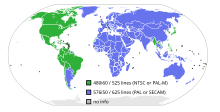Standard-definition television
This articleneeds additional citations forverification.(June 2022) |

Standard-definition television(SDTV;alsostandard definitionorSD) is a television system that uses a resolution that is not considered to be eitherhighorenhanced definition.[1]Standardrefers to offering a similar resolution to theanalog broadcast systemsused when it was introduced.[1][2]
History and characteristics[edit]
SDTV originated from the need for a standard to digitize analog TV (defined inBT.601) and is now used for digital TV broadcasts and home appliances such as game consoles and DVD disc players.[3][4]
Digital SDTV broadcast eliminates theghostingandnoisy imagesassociated with analog systems. However, if the reception has interference or is poor, where the error correction cannot compensate one will encounter various other artifacts such as image freezing, stuttering, or dropouts from missingintra-framesor blockiness from missingmacroblocks.The audio encoding is the last to suffer a loss due to the lower bandwidth requirements.[citation needed]
Standards that support digital SDTV broadcast includeDVB,ATSC,andISDB.[5]The last two were originally developed forHDTV,but are also used for their ability to deliver multiple SD video and audio streams viamultiple xing.
PAL and NTSC[edit]
The two SDTV signal types are576i(with 576interlacedlines of resolution,[6]derived from the European-developedPALandSECAMsystems), and480i(with 480 interlaced lines of resolution,[3]based on the AmericanNTSCsystem). SDTVrefresh ratesare 25, 29.97 and 30frames per second,again based on the analog systems mentioned.
In North America, digital SDTV is broadcast in the same4:3aspect ratioas NTSC signals, withwidescreencontent often beingcenter cut.[5]
In other parts of the world that used the PAL or SECAM color systems, digital standard-definition television is now usually shown with a16:9 aspect ratio,with the transition occurring between the mid-1990s and late-2000s depending on the region. Older programs with a 4:3 aspect ratio are broadcast witha flagthat switches the display to 4:3. Some broadcasters prefer to reduce the horizontal resolution by anamorphically scaling the video into apillarbox.[citation needed]
Pixel aspect ratio[edit]
| Video format | Display aspect ratio (DAR) | Resolution | Pixel aspect ratio (PAR) | After horizontal scaling |
|---|---|---|---|---|
| 480i | 4:3 | 704 × 480(horizontal blankingcropped) | 10:11 | 640 × 480 |
| 720 × 480(full frame) | 655 × 480 | |||
| 480i | 16:9 | 704 × 480(horizontal blankingcropped) | 40:33 | 854 × 480 |
| 720 × 480(full frame) | 873 × 480 | |||
| 576i | 4:3 | 704 × 576(horizontal blankingcropped) | 12:11 | 768 × 576 |
| 720 × 576(full frame) | 788 × 576 | |||
| 576i | 16:9 | 704 × 576(horizontal blankingcropped) | 16:11 | 1024 × 576 |
| 720 × 576(full frame) | 1050 × 576 |
The pixel aspect ratio is the same for 720- and 704-pixel resolutions because the visible image (be it 4:3 or 16:9) is contained in the center 704 horizontal pixels of the digital frame. In the case of a digital video line having 720 horizontal pixels (including horizontal blanking), only the center 704 pixels contain the actual 4:3 or 16:9 image, and the 8-pixel-wide stripes on either side are callednominal analog blankingorhorizontal blankingand should be discarded when displaying the image. Nominal analog blanking should not be confused withoverscan,as overscan areas are part of the actual 4:3 or 16:9 image.
ForSMPTE 259M-Ccompliance, an SDTV broadcast image is scaled to 720 pixels wide for every 480 NTSC (or 576 PAL) lines of the image with the amount of non-proportional line scaling dependent on either the display orpixel aspect ratio.Only 704 center pixels contain the actual image and 16 pixels are reserved forhorizontal blanking,though a number of broadcasters fill the whole 720 frames.[citation needed]The display ratio for broadcast widescreen is commonly 16:9 (pixel aspect ratio of 40:33 foranamorphic); the display ratio for a traditional orletterboxedbroadcast is 4:3 (pixel aspect ratio of 10:11).
An SDTV image outside the constraints of the SMPTE standards requires no non-proportional scaling with 640 pixels (defined by the adopted IBMVGAstandard) for every line of the image. The display and pixel aspect ratio is generally not required with the line height defining the aspect. For widescreen 16:9, 360 lines define a widescreen image and for traditional 4:3, 480 lines define an image.
See also[edit]
- Digital Audio Broadcasting– Digital radio standard
- Moving Picture Experts Group– Alliance of working groups to set standards for multimedia coding
- Rec. 601– Standard from the International Telecommunication Union
References[edit]
- ^ab"standard definition television (SDTV)".ATSC: NextGen TV.Retrieved2023-06-18.
- ^"HDTV".siliconimaging.Retrieved2023-06-18.
- ^ab"What means 480i?".afterdawn.
- ^"BT.601: Studio encoding parameters of digital television for standard 4:3 and wide screen 16:9 aspect ratios".ITU.
- ^ab"All-Digital Television Is Coming (And Sooner Than You Think!)".Federal Communications Commission.Archived fromthe originalon Sep 29, 2008.
- ^"What means 576i?".Afterdawn.
